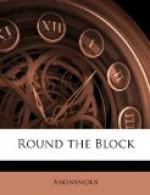The coroner was a jovial man, with a bulging forehead, a ruddy nose, a large diamond breastpin (a real diamond, of that superlative style only seen in its perfection on the shirt fronts of aldermen, contractors, and Washington Market butchers), and the native New York manner of speaking, which is sharp and mandatory. The coroner began life as a stone mason, gained early distinction as a fireman, controlled several hundred votes in his ward, became a member of a political committee, and got a coronership as his share of the spoils. He had aspired to be a police justice, or city inspector, or commissioner of the Croton Board. To either of these positions, or, for that matter, to any position indefinitely higher, he felt himself perfectly equal. But other members of the committee (which was a kind of joint-stock company for the distribution of offices) had prior and stronger claims than Harry Bullfast, and so he was put off with a coronership. He felt the slight acutely, but, like a prudent man, determined to so keep himself before the public in his performance of the office, as to make it a stepping stone to something much higher—the city comptrollership, or a seat in the State Senate, or in Congress, or (who could tell?) the governorship of the commonwealth—that grand possibility which every ward politician carries in his hat.
The coroner was seated in the inventor’s private armchair, with one leg thrown over the side of it, and the other stretched on the floor. He was chewing tobacco with manly vigor, and cracking jokes with a facetious juryman, who was assistant foreman of the Bully Boy Hose, of which the coroner was an exempt and honorary member.
The jury was composed of six men whom the coroner had picked from the large number of idle spectators found by him at the scene of the murder when he was first summoned. Two of them chanced to be acquaintances of his. As to the rest, the coroner had not the remotest idea. They might have been beggars or pickpockets, for aught that he cared. They looked stupid, and he liked stupid jurors.
“Them sharp fellers that thinks they knows more’n the cor’ner, is a cussed nuisance,” he often had occasion to remark.
The jury sat near one of the windows, in a semicircle of chairs which had been borrowed from the first and second floors. Pending the resumption of their melancholy work, such of them as could read were reading newspapers containing reports of the first day’s proceedings, from two to ten columns long, wherein the scene of the “Mysterious Midnight Tragedy,” as one paper called it, was represented in the most ingenious manner by printers’ rules cut to show the dimensions of the rooms on the third floor, the position of the fireplace, bed, washstand, chest of drawers, unknown machine in the corner, and other things which had no bearing whatever on the affair. The other jurors, who could not read at all, or had an insuperable aversion to that laborious occupation, were rolling their quids in silence, and looking wise.




